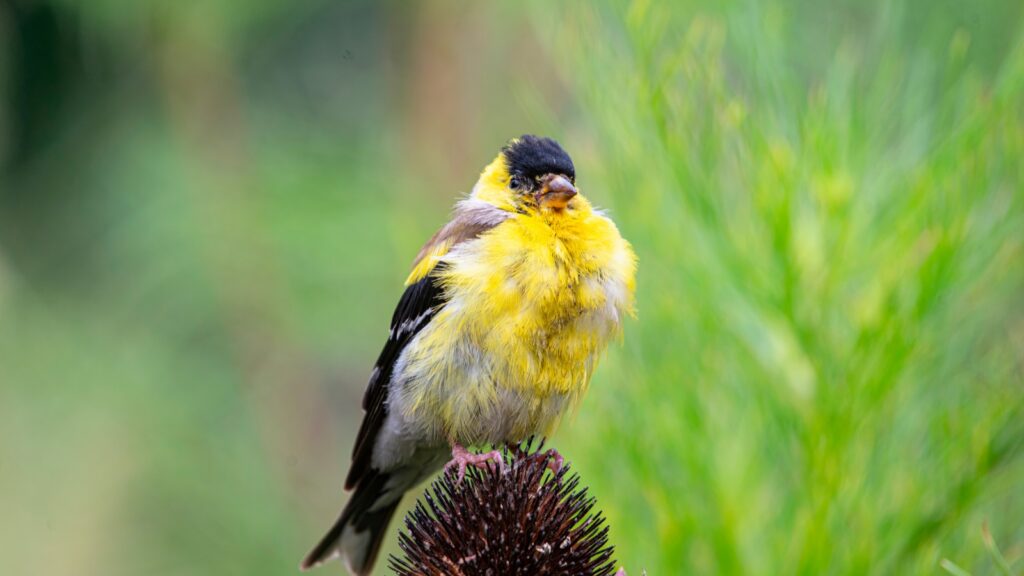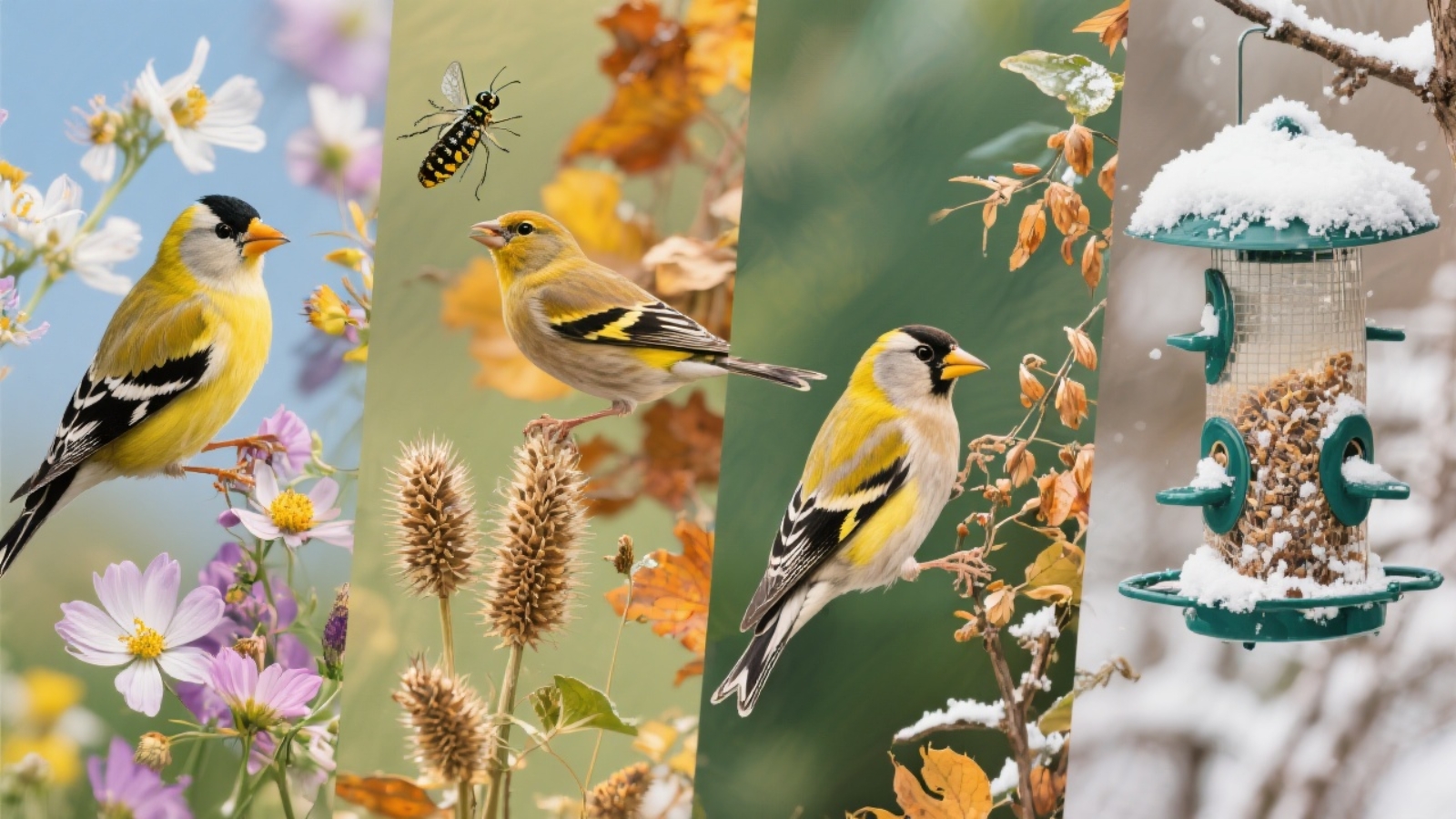Goldfinches are among Britain’s most beloved garden visitors, instantly recognisable by their vibrant yellow plumage and cheerful calls. Understanding what goldfinches eat is essential for anyone wanting to attract these beautiful birds to their garden.
Their specialised diet consists primarily of seeds, with nyjer seeds and thistle seeds being their absolute favourites, though their feeding habits are more complex and seasonal than many people realise.
This comprehensive guide covers everything you need to know about the goldfinch diet, from their natural food preferences to the best ways to feed them in your garden throughout the year.
Quick Answer: What Do Goldfinches Eat?
Goldfinches primarily eat seeds, with nyjer (thistle) seeds being their top preference. Their diet includes sunflower seeds, dandelion seeds, asters, and various wildflower seeds.
During the breeding season, they also consume small insects and aphids to provide protein for their young. In gardens, they’re attracted to specialist bird feeders filled with nyjer seed and sunflower hearts.
Natural Diet of Wild Goldfinches
Wild goldfinches have evolved as specialist seed-eaters with a particular preference for small, oil-rich seeds. Their pointed beaks are perfectly adapted for extracting seeds from thistles, dandelions, and other composite flowers.
Primary natural food sources include:
- Thistle seeds (Carduus and Cirsium species)
- Dandelion seeds (Taraxacum officinale)
- Aster seeds
- Ragwort seeds
- Burdock seeds
- Teasel seeds.

During late summer and autumn, goldfinches perform their famous feeding displays on seed heads, often hanging upside down to reach the best seeds. This behaviour makes them particularly entertaining to watch and explains why they’re sometimes called “charm of goldfinches” when feeding in groups.
The timing of their breeding season (May to September) coincides with peak seed availability, demonstrating their evolutionary adaptation to their specialised diet.
Best Seeds for Feeding Goldfinches
When attracting goldfinches to your garden, choosing the right seeds makes all the difference. Nyjer seed remains the gold standard for goldfinch feeding, but several other options prove equally effective.
Top seed choices for goldfinches:
- Nyjer seeds: The ultimate goldfinch magnet, rich in oils and perfectly sized
- Sunflower hearts: High-energy option without messy shells
- Niger seed: Alternative name for nyjer, sourced from Guizotia abyssinica
- Mixed finch seed blends containing nyjer and small seeds.
Sunflower seeds (both striped and black oil varieties) also attract goldfinches, though they prefer the hearts over whole seeds. The key is offering seeds that are small enough for their delicate beaks but rich enough in oils to provide substantial nutrition.
Quality matters significantly when selecting bird seed. Fresh, properly stored seeds maintain their oil content and remain attractive to goldfinches longer than stale alternatives.
Seasonal Feeding Patterns
Goldfinch feeding behaviour changes dramatically throughout the year, influenced by natural food availability and breeding requirements.
Spring (March-May): Goldfinches seek high-energy foods to prepare for breeding. Garden feeders become crucial as natural seed sources remain limited. This period offers the best opportunity to attract goldfinches to your garden year-round.
Summer (June-August): During breeding season, adult goldfinches supplement their seed diet with small insects and aphids, providing essential protein for developing chicks. They continue visiting feeders but may appear less frequently.
Autumn (September-November): Peak feeding time as goldfinches build fat reserves for winter. Natural seed heads provide abundant food, but garden feeders remain popular, especially during poor weather.
Winter (December-February): Garden feeders become lifelines when natural food sources are buried under snow or depleted. Goldfinches form larger flocks and visit feeders more regularly.

Protein Sources and Insects
While seeds form the bulk of their diet, goldfinches do eat insects, particularly during the breeding season. Adult birds catch small insects and aphids to feed their chicks, as growing birds require more protein than seeds alone can provide.
Common insect prey includes:
- Aphids
- Small caterpillars
- Flying ants
- Tiny beetles
- Plant lice.
This protein requirement explains why goldfinches often feed in areas with healthy plant populations that support insect communities. Gardens using organic growing methods typically attract more goldfinches because they harbour more insects.
Parent goldfinches regurgitate partially digested seeds mixed with insects to feed their young, creating a perfect nutritional balance for rapid chick development.
Best Feeder Types for Goldfinches
The right bird feeder design significantly impacts goldfinch visitation success. These acrobatic birds can feed from various feeder styles, but some designs work better than others.
Optimal feeder types:
- Nyjer feeders with multiple feeding ports
- Mesh sock feeders filled with Nyjer seed
- Small seed feeders with adjustable perches
- Tube feeders designed specifically for finches.
Mesh feeders work particularly well because goldfinches can cling to any angle while feeding, mimicking their natural behaviour on seed heads. Multiple feeding ports allow several birds to feed simultaneously, accommodating their social nature.
Feeder placement matters equally. Position feeders near natural cover but with clear sightlines for spotting predators. Height isn’t critical since goldfinches feed at various levels in the wild.
Foods to Avoid Giving Goldfinches
Not all bird foods suit goldfinches, and some can actually harm them. Understanding what not to feed goldfinches protects both the birds and your feeding success.
Avoid these foods:
- Bread and baked goods
- Salted nuts or seeds
- Chocolate or caffeine-containing items
- Mouldy or rancid seeds
- Large seeds like corn or peanuts in shells.
Bread provides no nutritional value and can cause serious health problems if it becomes a significant portion of their diet. Mouldy seeds contain toxins that can be fatal to small birds.
Stick to high-quality, fresh seeds from reputable suppliers. Proper bird seed storage maintains nutritional value and prevents spoilage.
Attracting Goldfinches to Your Garden
Creating an attractive environment for goldfinches involves more than just providing the right food. These birds appreciate gardens that offer diverse feeding opportunities and natural habitat features.
Garden features that attract goldfinches:
- Native wildflower patches with seed-producing plants
- Thistle and dandelion areas (if appropriate for your garden style)
- Fresh water sources like bird baths
- Mixed plantings providing year-round seed sources.
Allow some areas of your garden to “go wild” during autumn, leaving seed heads standing through winter. This natural approach supplements feeder offerings and provides the varied diet goldfinches prefer.
Consistency in feeding proves more important than quantity. Regular refilling of feeders trains goldfinches to rely on your garden as a food source.
Conclusion and Key Takeaways
Understanding what goldfinches eat enables successful garden bird feeding and creates rewarding wildlife watching opportunities. Focus on providing fresh nyjer seeds in appropriate feeders, supplement with sunflower hearts, and maintain consistent feeding schedules.
Remember that goldfinches appreciate both natural and supplemental food sources, so combining feeders with seed-producing plants creates the most attractive garden environment for these charming birds.
Frequently Asked Questions
Q: How often should I refill goldfinch feeders? A: Refill feeders every 2-3 days in summer and weekly in winter, or whenever they’re empty. Fresh seed attracts more birds than stale offerings.
Q: Can goldfinches eat sunflower seeds? A: Yes, goldfinches readily eat both black oil sunflower seeds and sunflower hearts, though they prefer hearts because they’re easier to handle.
Q: Do goldfinches eat insects? A: Adult goldfinches eat insects primarily during breeding season to provide protein for their chicks. Seeds remain their primary food source year-round.
Q: What’s the difference between nyjer and niger seed? A: They’re the same thing. “Niger” is the traditional spelling, while “nyjer” is a trademarked spelling used to distinguish bird food from other uses of the word.
Q: Why aren’t goldfinches visiting my feeder? A: Common reasons include stale seed, wrong feeder type, poor location, or lack of nearby cover. Try fresh nyjer seed in a proper finch feeder near a natural shelter.
Q: When is the best time to start feeding goldfinches? A: Year-round feeding works best, but spring (March-April) is ideal for establishing new feeding stations when natural food sources are limited.
Q: Can I grow plants to feed goldfinches naturally? A: Absolutely. Plant native wildflowers, let thistles grow in appropriate areas, and allow seed heads to remain through winter for natural feeding opportunities.
